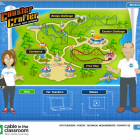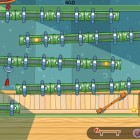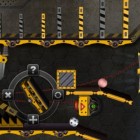By Tanner Higgin, Graphite
Chances are, if you have a smartphone or tablet, you've played Angry Birds. While Candy Crush Saga might currently top the charts, Angry Birds is the best selling app of all time. From an educator's perspective, what's exciting about Angry Birds' popularity versus something like Candy Crush is that getting good at Angry Birds means skillfully – and often unconsciously – using conceptual physics knowledge. It's something video games have been doing for years, but Angry Birds brought it to a mass audience, sneaking a bit of science into many students' digital diets.
Here are five other games for the Angry Birds fan that do an even better job of integrating physics and problem solving into addictive, just-one-more-try experiences.
 1. Crayon Physics Deluxe
1. Crayon Physics Deluxe
The first of two indie classics on this list, Crayon Physics Deluxe might be five years old, but it has aged well. The crayon drawing aesthetic and free-form puzzle solving -- which allow students to draw objects into the level -- encourage students to use simple machines and conceptual physics creatively. One teacher has also used it to teach students the iterative process of design and engineering.
 2. World of Goo
2. World of Goo
The second classic, World of Goo, garnered two different awards for design at the 2008 Independent Games Festival (Crayon Physics won the Grand Prize). In World of Goo, players build structures out of the titular black goo. As structures climb higher, or bridge gaps, students start thinking about weight distribution, gravity, and center of mass.
 3. Coaster Crafter
3. Coaster Crafter
Roller coasters have long been a favorite example for physics teachers. They're a great way to show students the practical implications of concepts like velocity and kinetic and potential energy. Coaster Crafter features a few different modes that will take students step by step through the process of designing coasters, connecting each step and challenge to important physics concepts. The mode that has students fix broken tracks was a particular favorite of a physics teacher.
 4. Amazing Alex
4. Amazing Alex
A follow-up to Angry Birds by developer Rovio, Amazing Alex takes inspiration from Crayon Physics' template, but instead of drawing solutions, players combine 35 different interactive, household objects like scissors, tennis balls, and rope to make Rube Goldberg like contraptions. It's polished and captures the quirk of DIY culture in a way sure to grab the attention of students that like to get their hands dirty. Students are also encouraged to keep trying, helping them, as one teacher points out, learn perseverance.
 5. Tinkerbox
5. Tinkerbox
Tinkerbox is similar to Amazing Alex, but with an industrial vs. cartoonish art style. As a result, it still teaches many of the same concepts, but its thematic focus is more on machinery and engineering than homebrew creation. Like Amazing Alex, one of the best features of Tinkerbox is its level creator tool where students can build contraptions or puzzles and share them with others. It's a handy alternative for teachers who are looking to broaden their assessment strategies. As one teacher argues, tools like Tinkerbox can "be as valuable as even the best of lectures."

